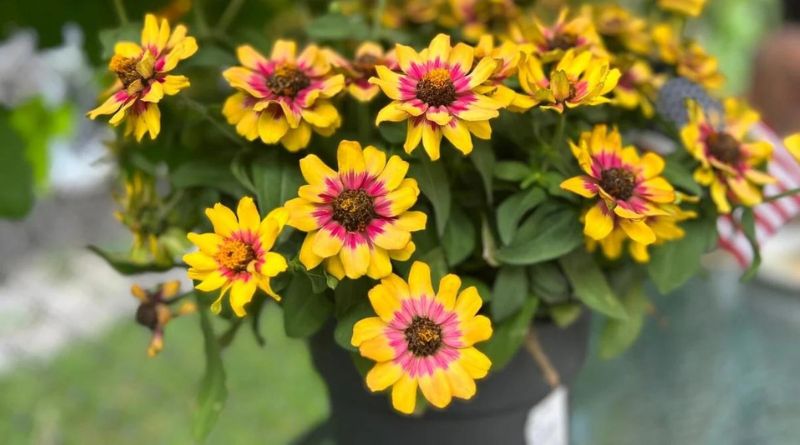Zinnias are among the most vibrant and easy-to-grow flowers that can add a splash of color to any garden. However, many gardeners seek ways to make their zinnias bushier and more prolific in their blooming. Here are nine tried-and-true tricks to help you achieve a lush and flowerful zinnia garden.
1. Pinch Early and Often

Pinching is a crucial technique to encourage branching and bushiness in zinnias. When your zinnia plants are about 4-6 inches tall and have developed a few sets of leaves, pinch off the top set of leaves. This will stimulate the plant to produce multiple stems instead of a single stalk. Regular pinching throughout the growing season can significantly increase the number of blooms as each new branch will produce flowers. Be gentle while pinching to avoid damaging the plant, and ensure you’re pinching just above a leaf node for the best results.
2. Provide Adequate Spacing

Crowded zinnias compete for light, water, and nutrients, which can result in leggy growth and fewer flowers. To prevent this, space your zinnia plants about 12-18 inches apart, depending on the variety. Proper spacing allows for better air circulation, reducing the risk of diseases and encouraging more robust growth. Additionally, well-spaced plants receive more sunlight, essential for their overall health and blooming potential.
3. Fertilize Wisely

Zinnias are not heavy feeders, but they do benefit from the right nutrients. Use a balanced, slow-release fertilizer at planting time to provide steady nutrition. As the season progresses, a monthly application of a balanced liquid fertilizer can help maintain strong growth and abundant blooming. Avoid over-fertilizing, particularly with high-nitrogen fertilizers, as this can lead to excessive foliage at the expense of flowers. Organic options like compost or worm castings can also provide a gentle, nutrient-rich boost.
4. Water Consistently

Consistent watering is key to healthy, bushy zinnias. Water deeply and regularly, ensuring the soil stays evenly moist but not waterlogged. Inconsistent watering can stress the plants, leading to poor growth and fewer flowers. Mulching around your zinnias can help retain soil moisture and reduce the need for frequent watering. Water at the base of the plants to keep the foliage dry and minimize the risk of fungal diseases, especially in humid conditions.
5. Deadhead Regularly

Deadheading, or removing spent blooms, encourages zinnias to produce more flowers. Once a flower starts to fade, snip it off just above the nearest set of leaves or a lateral bud. This process prevents the plant from putting energy into seed production and instead redirects it towards generating new blooms. Regular deadheading throughout the growing season will keep your zinnias looking fresh and vibrant, promoting a continuous display of flowers.
6. Prune for Shape and Health

Pruning isn’t just for pinching and deadheading; it can also help maintain the overall shape and health of your zinnia plants. If certain stems start to dominate or if the plant becomes too dense, selectively prune some branches to open up the center and improve air circulation. This can prevent fungal issues and help the plant allocate resources more efficiently, resulting in a bushier and healthier zinnia.
7. Choose the Right Varieties

Some zinnia varieties naturally grow bushier than others. When selecting seeds or plants, opt for varieties known for their branching habits and prolific blooming, such as ‘Profusion,’ ‘Zahara,’ or ‘Benary’s Giant.’ These varieties have been bred for robust growth and abundant flowers, making them ideal choices for gardeners looking to enhance the fullness and bloom power of their zinnia patch.
8. Control Pests and Diseases

Healthy zinnias are more likely to grow bushier and produce more flowers. Keep an eye out for common pests like aphids, spider mites, and whiteflies, and take action promptly if infestations occur. Use insecticidal soap, neem oil, or introduce beneficial insects like ladybugs to keep pest populations in check. Additionally, practice good garden hygiene by removing diseased leaves and spent plant material to prevent the spread of fungal diseases. Healthy plants can focus their energy on growing and blooming rather than recovering from pest or disease damage.
9. Rotate Crops and Amend Soil

Rotating your zinnia planting area each year can prevent soil-borne diseases and nutrient depletion. If you can’t rotate, amend the soil annually with organic matter like compost or well-rotted manure to replenish nutrients and improve soil structure. Healthy, nutrient-rich soil promotes vigorous growth and abundant flowering. Soil amendments also enhance drainage and aeration, crucial for preventing root rot and encouraging healthy root development, which in turn supports bushier, more flowerful plants.
By implementing these nine tricks, you’ll be well on your way to cultivating zinnias that are not only bushier but also brimming with vibrant, show-stopping blooms. Happy gardening!
